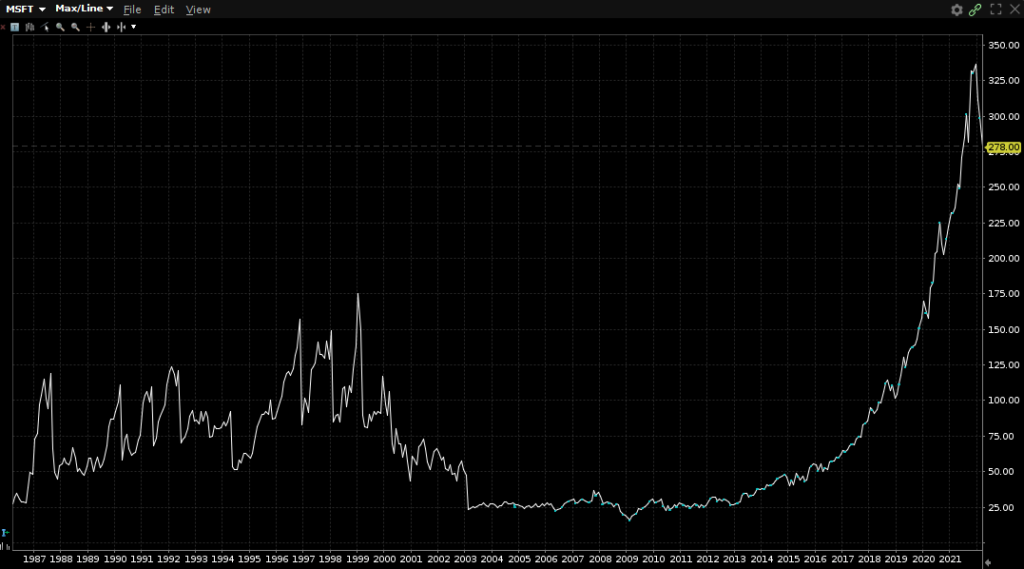Why Price Matters In Equity Investing
As we have seen in chapter One with the horses and in chapter Two with Mr Market, it isn’t just the quality of the business that matters when investing, price is all important.
“Price is what you pay, value is what you get”
Warren Buffett
Economic reality is value and is based on the economic fundamentals of a business. Price is a momentary measure of the mood swings of Mr Market, nothing more and nothing less. Understanding this is important because a good investor looks for a great company at an attractive price. One must be mindful that price often exceeds value and in such circumstances even the best company will become a bad investment as I shall demonstrate in this chapter with reference to Microsoft.
“A great company at the wrong price makes for a poor investment”
Benjamin Graham
Case Study: Microsoft
Microsoft has consistently been one of the best performing companies of the last 50 years, but it hasn’t always been a great investment. This is exactly what Graham was warning about. Allow me to demonstrate.
In the year 2000 Microsoft was the darling of the stock market. Its market capitalisation was $620 billion and it accounted for 5.3% of the value of the entire S&P500 index.
Having had its IPO in 1986 the fourteen years that followed were mind-blowing – annual growth rates were 43% for sales, 51% for earnings and 68% in terms of its market capitalisation.
The problem stemmed not from the business, which would continue growing its top and bottom lines at rates that were well in excess of other companies and of the economy as a whole. The problem was the price, which at 31 times sales and 80 times earnings, was way, way ahead of the business.
With a P/S multiple of 31x, even if Microsoft had been able to convert all of its revenue into profit (which no business ever can), investors would have seen only a 3.2% earnings yield on invested capital. That would fall far short of the hurdle rate for any rational investor.
So how much of the revenue did Microsoft convert into profit? The answer is that it had an impressive 39% net margin and so the earnings yield offered to the investor at that time was a paltry 1.25%. This is confirmed by the P/E multiple of 80x which also equates to a 1.25% earnings yield.
Who in their right mind invests in an equity offering a 1.25% return when risk-free ten year Treasuries were offering 6.03%? As Benjamin Graham said in his 1949 book the Intelligent Investor, “A great company at the wrong price makes for a poor investment”. Microsoft was a great company, but it was at the wrong price for investors in the year 2000.
The primary issue is that when price runs too far ahead of value, as was the case here, there will always be a period of consolidation that follows. Either the price will drop back in line with intrinsic value, or else price will stagnate for many years until the fundamentals of the business catch up with the price. It was the latter that happened with Microsoft.
From the year 2000 until the end of 2019 Microsoft continued to experience outstanding growth. Revenue grew at 9.4% per year increasing from $21.8 billion to $134 billion over the period. Profits grew at 7.9% per year increasing from $8.7 billion to $41.6 billion. As an added kicker, because the company repurchased a net 26% of its outstanding shares during that period, the earnings per share grew by 9.9% per year. Yet this time the share price massively under-performed the growth in the business because it was working-off its initial enormous overvaluation.
So despite sales increasing six-fold and profits increasing five-fold, the market cap in the same period only doubled which amounts to a capital appreciation for the poor investor of 3.6% CAGR, plus dividends which pushed the total return to 5.9% per annum.
The chart below shows how the share price trended upwards between the IPO and 1999, but then consolidated for 20 years. Had you invested in 1999 before the correction, your position would have been down until 2020 (more if you factor in the cost of capital plus equity premium).

At the turn of the millennium Microsoft was a case of the great business at the wrong price. The earnings multiple of 80x in the year 2000 was the clue for the investor. By the end of 2019 the multiple had pulled back to a more reasonable 35x, meaning that an investor lost 59.6% to multiple contraction over the period.
In other words, the 9.9% increase in earnings per share over the period was diluted because the multiple of earnings that the market was using to price the shares had fallen 59.6% – and so 59.6% of 9.9% is the 5.9% return achieved by the investor because he overpaid for his shares in the first place!
I hope that this example has hammered home that price matters really does matter for any investment.
>> Next Page
